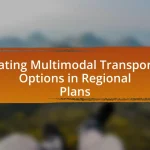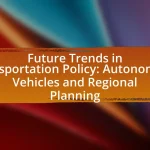Regional transportation authorities are facing significant challenges due to changing demographics, including aging populations, urbanization, and increasing diversity. These shifts necessitate adaptations in service delivery, infrastructure planning, and community engagement to meet the evolving transportation needs of diverse populations. Key strategies for adaptation include enhancing accessibility, leveraging data analytics for informed decision-making, and fostering community involvement in planning processes. Additionally, addressing financial constraints and promoting innovative service models are crucial for ensuring effective and equitable transportation solutions. The article outlines the implications of these demographic trends and provides practical steps for transportation authorities to successfully adapt their services.
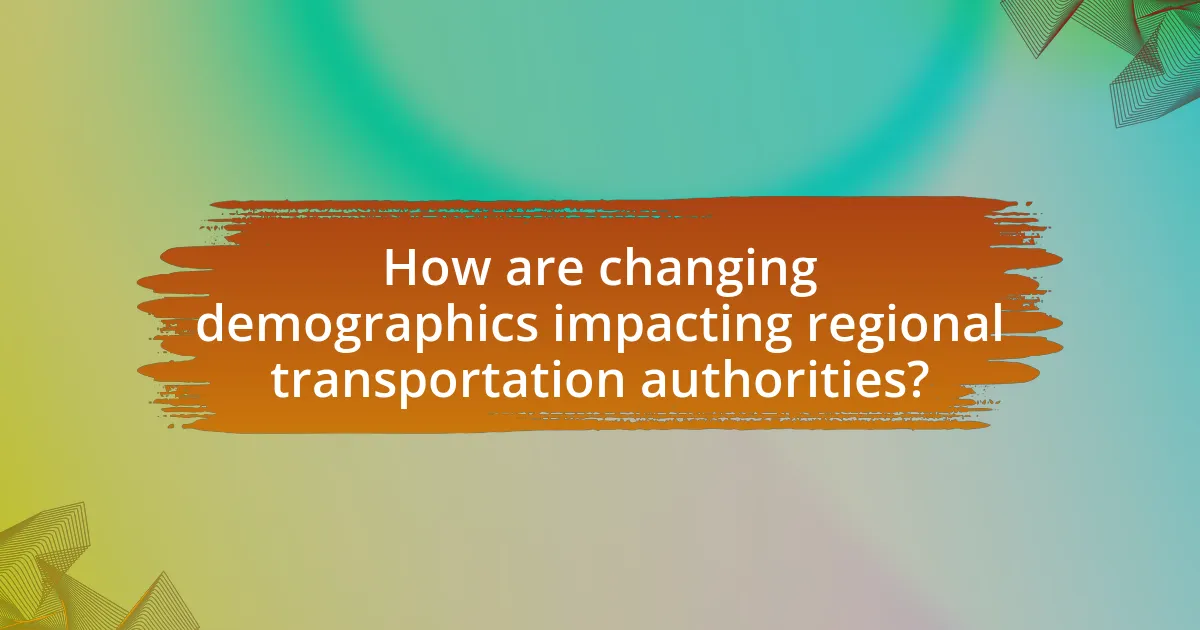
How are changing demographics impacting regional transportation authorities?
Changing demographics are significantly impacting regional transportation authorities by necessitating adjustments in service delivery and infrastructure planning. As populations age, there is an increased demand for accessible transportation options, prompting authorities to enhance services for seniors, such as paratransit and on-demand ride services. Additionally, urbanization trends lead to higher densities in metropolitan areas, requiring authorities to invest in public transit systems that can accommodate increased ridership and reduce congestion. For instance, the American Public Transportation Association reported that public transit ridership increased by 2.2% in urban areas from 2018 to 2019, reflecting the need for expanded services. Furthermore, the rise in diverse populations necessitates multilingual services and culturally competent outreach strategies to ensure equitable access. These demographic shifts compel regional transportation authorities to adapt their planning and operations to meet the evolving needs of their communities effectively.
What demographic trends are currently influencing transportation needs?
Current demographic trends influencing transportation needs include urbanization, aging populations, and increasing diversity. Urbanization drives higher demand for public transit as more people move to cities, with over 55% of the global population living in urban areas as of 2020. Aging populations require accessible transportation options, as individuals aged 65 and older are projected to reach 1.5 billion by 2050, necessitating services that accommodate mobility challenges. Additionally, increasing diversity in communities leads to varied transportation preferences and needs, with studies indicating that minority populations often rely more on public transit compared to their white counterparts. These trends highlight the necessity for regional transportation authorities to adapt their services to meet the evolving demands of their populations.
How does population aging affect transportation services?
Population aging significantly impacts transportation services by increasing demand for accessible and reliable transit options tailored to older adults. As the proportion of elderly individuals rises, transportation authorities must adapt by enhancing services such as paratransit, which provides door-to-door transport for those with mobility challenges. According to the American Public Transportation Association, nearly 80% of older adults prefer to age in place, necessitating improved public transit systems that accommodate their needs. Additionally, studies indicate that older adults are more likely to rely on public transportation, leading to a greater need for frequency and safety measures in transit services.
What role does urbanization play in transportation demand?
Urbanization significantly increases transportation demand due to higher population density and the concentration of economic activities in urban areas. As cities grow, more people require efficient transportation options to commute for work, education, and leisure, leading to a surge in public transit usage and private vehicle ownership. For instance, the United Nations reported that by 2050, 68% of the global population is expected to live in urban areas, which correlates with increased traffic congestion and a greater need for sustainable transportation solutions. This trend necessitates that regional transportation authorities adapt their infrastructure and services to meet the evolving demands of urban populations.
Why is it important for transportation authorities to adapt to these changes?
Transportation authorities must adapt to changes in demographics to ensure efficient and equitable transportation services. As populations shift, including aging populations and urbanization trends, transportation needs evolve, necessitating adjustments in service delivery. For instance, the U.S. Census Bureau projects that by 2030, all baby boomers will be older than 65, increasing demand for accessible transportation options. Adapting to these demographic changes allows authorities to enhance mobility, reduce congestion, and improve overall public satisfaction with transportation systems.
What are the consequences of failing to adapt to demographic shifts?
Failing to adapt to demographic shifts can lead to significant operational inefficiencies and decreased service effectiveness for regional transportation authorities. When authorities do not align their services with the changing needs of diverse populations, they risk underutilization of resources, resulting in financial losses. For instance, a study by the American Public Transportation Association indicates that public transit systems that do not adjust to demographic trends may experience a decline in ridership by up to 20%, as services become less relevant to the community’s needs. Additionally, neglecting demographic changes can exacerbate social inequities, as marginalized groups may face increased barriers to mobility, further isolating them from essential services and opportunities.
How can adaptation improve service delivery and user satisfaction?
Adaptation can improve service delivery and user satisfaction by allowing regional transportation authorities to tailor their services to meet the evolving needs of diverse populations. For instance, adapting routes and schedules based on demographic shifts, such as increased demand for public transit in urban areas, can enhance accessibility and convenience for users. Research from the American Public Transportation Association indicates that agencies that implement adaptive strategies see a 20% increase in ridership and user satisfaction ratings. This demonstrates that responsiveness to demographic changes directly correlates with improved service outcomes and user experiences.
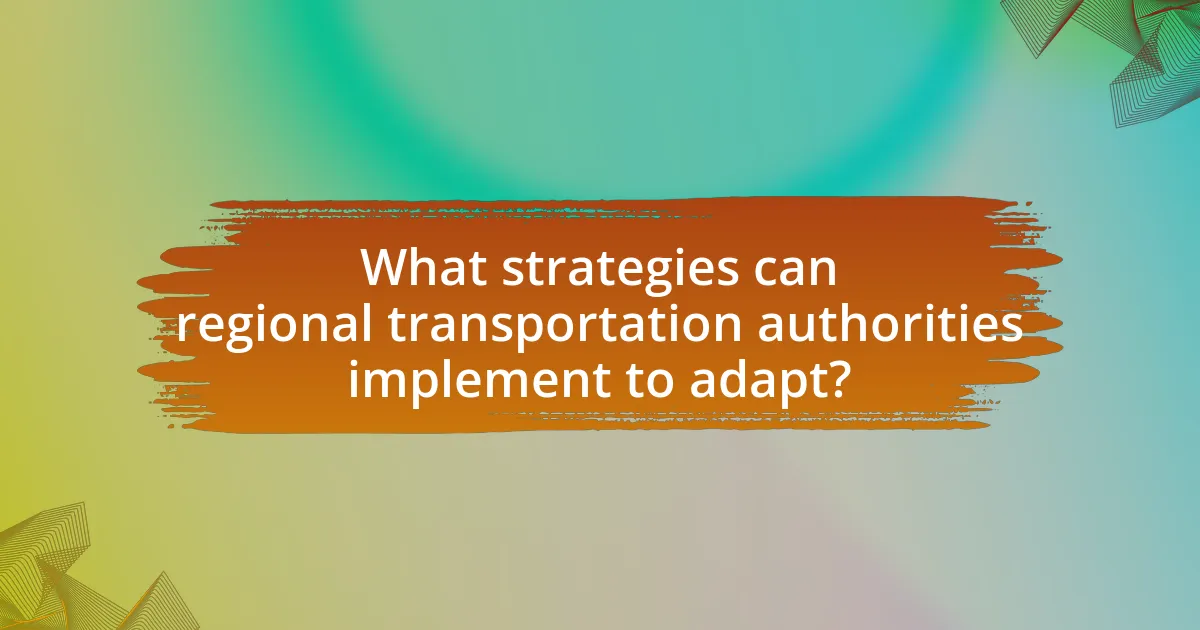
What strategies can regional transportation authorities implement to adapt?
Regional transportation authorities can implement strategies such as enhancing public transit accessibility, integrating technology for real-time data, and promoting multimodal transportation options to adapt to changing demographics. Enhancing public transit accessibility involves expanding services to underserved areas, ensuring that transportation is available to diverse populations, including the elderly and disabled. Integrating technology, such as mobile apps for real-time tracking and payment systems, improves user experience and attracts younger demographics who prefer digital solutions. Promoting multimodal transportation options, including bike-sharing and ride-hailing partnerships, caters to varying preferences and encourages sustainable travel. These strategies are supported by studies indicating that improved accessibility and technology integration lead to increased ridership and satisfaction among diverse user groups.
How can data analytics inform transportation planning?
Data analytics can inform transportation planning by providing insights into travel patterns, demand forecasting, and resource allocation. By analyzing data from various sources such as traffic sensors, public transit usage, and demographic information, transportation planners can identify trends and make data-driven decisions. For instance, a study by the American Public Transportation Association found that cities using data analytics for transit planning improved service efficiency by up to 20%. This demonstrates that leveraging data analytics enables regional transportation authorities to adapt their services to meet the evolving needs of changing demographics effectively.
What types of data should be collected to understand demographic changes?
To understand demographic changes, data on population size, age distribution, gender, ethnicity, income levels, education attainment, and migration patterns should be collected. These data types provide insights into the composition and dynamics of a population, which are essential for planning and adapting transportation services. For instance, the U.S. Census Bureau provides comprehensive demographic data that reveals shifts in population characteristics over time, allowing regional transportation authorities to align their services with the evolving needs of the community.
How can predictive analytics enhance service responsiveness?
Predictive analytics enhances service responsiveness by enabling regional transportation authorities to anticipate demand patterns and optimize resource allocation. By analyzing historical data, such as ridership trends and demographic shifts, authorities can forecast peak usage times and adjust schedules accordingly. For instance, a study by the American Public Transportation Association found that agencies using predictive analytics improved on-time performance by 15% and reduced operational costs by 10%. This data-driven approach allows for timely adjustments in service offerings, ensuring that transportation systems meet the evolving needs of diverse populations effectively.
What role does community engagement play in adaptation strategies?
Community engagement is crucial in adaptation strategies as it fosters collaboration between authorities and the public, ensuring that the needs and preferences of diverse populations are addressed. Engaging communities allows regional transportation authorities to gather valuable insights and feedback, which can inform the development of more effective and inclusive transportation solutions. For instance, studies have shown that when communities are actively involved in planning processes, projects are more likely to meet local needs and achieve higher levels of public support, leading to successful implementation. This participatory approach not only enhances the relevance of adaptation strategies but also builds trust and strengthens relationships between authorities and community members, ultimately contributing to more resilient transportation systems in the face of changing demographics.
How can transportation authorities effectively gather community input?
Transportation authorities can effectively gather community input by implementing a combination of surveys, public meetings, and digital engagement platforms. Surveys allow for quantitative data collection from a broad audience, while public meetings facilitate direct interaction and discussion, enabling authorities to address community concerns in real-time. Digital engagement platforms, such as social media and dedicated websites, provide accessible channels for ongoing feedback and information sharing. Research indicates that communities with active participation in transportation planning see a 30% increase in project approval rates, demonstrating the importance of inclusive input in decision-making processes.
What are best practices for involving diverse populations in planning?
Best practices for involving diverse populations in planning include actively engaging community members through inclusive outreach strategies, ensuring representation in decision-making processes, and utilizing culturally relevant communication methods. Engaging community members can be achieved by hosting public forums, workshops, and surveys that are accessible to all demographics, which fosters a sense of ownership and encourages participation. Representation in decision-making can be enhanced by forming advisory committees that reflect the community’s diversity, allowing for varied perspectives to influence planning outcomes. Culturally relevant communication methods, such as multilingual materials and community liaisons, ensure that information is accessible and resonates with different cultural groups. These practices are supported by studies indicating that inclusive planning leads to more equitable and effective outcomes, as seen in the work of the American Planning Association, which emphasizes the importance of community engagement in urban planning.
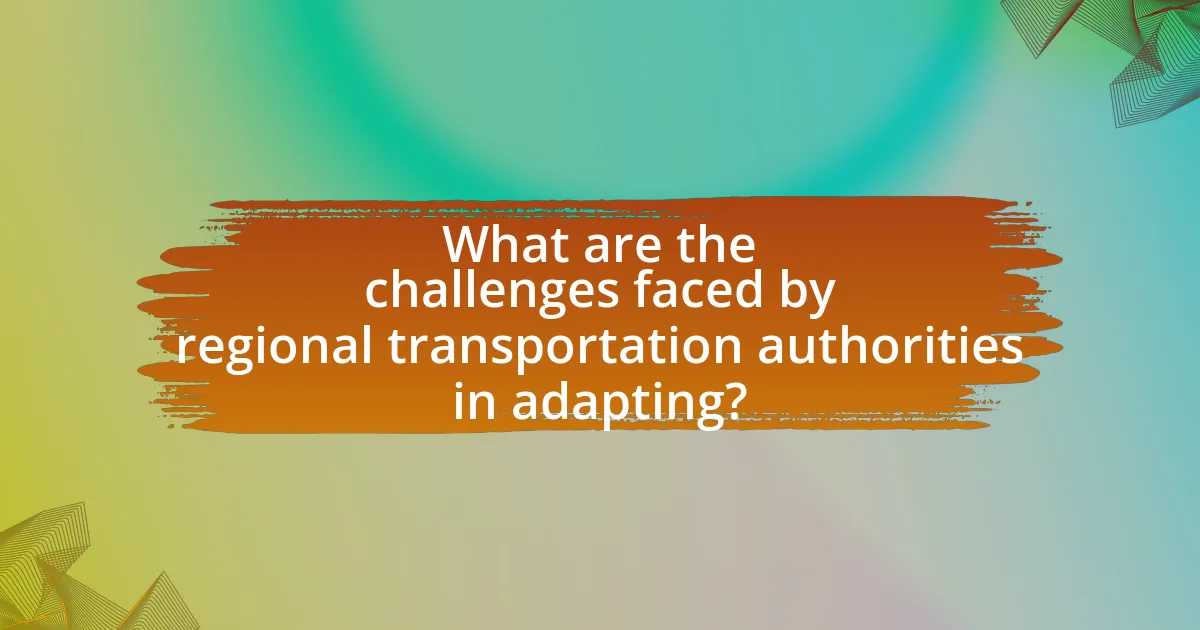
What are the challenges faced by regional transportation authorities in adapting?
Regional transportation authorities face several challenges in adapting to changing demographics, including funding constraints, infrastructure limitations, and the need for innovative service models. Funding constraints arise as authorities struggle to secure adequate financial resources to implement necessary changes, particularly in areas with declining ridership or budget cuts. Infrastructure limitations hinder the ability to expand or modify existing transit systems to meet the needs of diverse populations, especially in rapidly growing urban areas. Additionally, the need for innovative service models, such as on-demand transit options, presents a challenge as authorities must balance traditional fixed-route services with flexible solutions that cater to varying demographic needs. These challenges are compounded by the increasing demand for sustainable and equitable transportation options, requiring authorities to rethink their strategies and operations.
What financial constraints impact adaptation efforts?
Financial constraints that impact adaptation efforts include limited funding, budget cuts, and competing financial priorities. Regional transportation authorities often face challenges in securing adequate financial resources due to reliance on government funding, which can fluctuate based on economic conditions and policy changes. For instance, a report by the American Public Transportation Association indicates that public transit agencies have experienced significant budget shortfalls, leading to reduced service levels and hindered adaptation initiatives. Additionally, the need to allocate funds to existing infrastructure maintenance can divert resources away from innovative adaptation projects, further complicating efforts to respond to changing demographics effectively.
How can funding sources be diversified to support adaptation?
Funding sources can be diversified to support adaptation by integrating public-private partnerships, leveraging federal and state grants, and exploring innovative financing mechanisms such as green bonds. Public-private partnerships allow regional transportation authorities to share risks and resources, enhancing investment in adaptive infrastructure. Federal and state grants provide essential funding opportunities, with programs like the Federal Transit Administration’s grants specifically aimed at improving transportation systems. Additionally, green bonds can attract private investment for environmentally sustainable projects, thus broadening the financial base for adaptation initiatives. These strategies collectively enhance the financial resilience of transportation authorities in response to changing demographics.
What are the implications of budget cuts on service quality?
Budget cuts significantly reduce service quality by limiting resources available for operations, maintenance, and staffing. For instance, a study by the American Public Transportation Association found that a 10% reduction in funding can lead to a 15% decrease in service frequency and reliability. This decline in service quality often results in longer wait times, reduced accessibility, and increased customer dissatisfaction, ultimately undermining the effectiveness of regional transportation authorities in meeting the needs of changing demographics.
How can resistance to change within organizations be addressed?
Resistance to change within organizations can be addressed by implementing effective communication strategies and involving employees in the change process. Research indicates that organizations that foster open dialogue and transparency about the reasons for change experience less resistance. For example, a study by Kotter and Schlesinger (2008) highlights that engaging employees in discussions and soliciting their feedback can significantly reduce anxiety and opposition. Additionally, providing training and support during transitions helps employees feel more competent and confident, further mitigating resistance.
What strategies can be employed to foster a culture of innovation?
To foster a culture of innovation, regional transportation authorities can implement strategies such as encouraging collaboration, promoting risk-taking, and investing in continuous learning. Encouraging collaboration among diverse teams enhances creativity and leads to innovative solutions, as evidenced by studies showing that diverse teams outperform homogeneous ones in problem-solving. Promoting risk-taking allows employees to experiment without fear of failure, which is crucial for innovation; organizations like Google have successfully adopted this approach, leading to groundbreaking products. Investing in continuous learning through training and development programs equips employees with the latest skills and knowledge, fostering an environment where innovation can thrive.
How can training and development support staff in adapting to new demands?
Training and development can support staff in adapting to new demands by equipping them with the necessary skills and knowledge to meet evolving challenges. For instance, targeted training programs can enhance employees’ competencies in areas such as technology use, customer service, and regulatory compliance, which are critical in the context of changing demographics in regional transportation. Research indicates that organizations that invest in employee training experience a 24% higher profit margin compared to those that do not, demonstrating the tangible benefits of such initiatives. By fostering a culture of continuous learning, staff can remain agile and responsive to new demands, ultimately improving service delivery and operational efficiency.
What practical steps can regional transportation authorities take to ensure successful adaptation?
Regional transportation authorities can ensure successful adaptation by implementing data-driven planning, enhancing public engagement, and investing in flexible infrastructure. Data-driven planning allows authorities to analyze demographic trends and travel patterns, ensuring services meet the evolving needs of the population. For instance, the American Public Transportation Association reported that agencies using real-time data can adjust routes and schedules to better serve changing demographics. Enhancing public engagement through surveys and community forums fosters collaboration and ensures that transportation solutions reflect the needs of diverse populations. Additionally, investing in flexible infrastructure, such as multi-modal transit options, accommodates various transportation preferences and increases accessibility. This approach aligns with findings from the National Academy of Sciences, which emphasizes the importance of adaptable systems in meeting future transportation demands.
How can pilot programs be used to test new services or approaches?
Pilot programs can be used to test new services or approaches by implementing small-scale trials that allow for real-world evaluation of their effectiveness and feasibility. These programs enable regional transportation authorities to gather data on user experience, operational challenges, and overall impact before committing to broader implementation. For instance, a pilot program may involve introducing a new transit route or service model in a specific area, allowing authorities to assess ridership patterns and community feedback. This method is supported by evidence from various transportation studies, which indicate that pilot programs can lead to informed decision-making and resource allocation, ultimately enhancing service delivery in response to changing demographics.
What metrics should be used to evaluate the success of adaptation initiatives?
To evaluate the success of adaptation initiatives, metrics such as ridership levels, service reliability, customer satisfaction, and cost-effectiveness should be utilized. Ridership levels indicate the extent to which the adapted services meet the needs of changing demographics, while service reliability measures the consistency of transportation schedules and availability. Customer satisfaction surveys provide insights into user experiences and areas for improvement, and cost-effectiveness assesses the financial sustainability of the initiatives. These metrics collectively offer a comprehensive view of how well adaptation initiatives align with the evolving demands of the population served.

